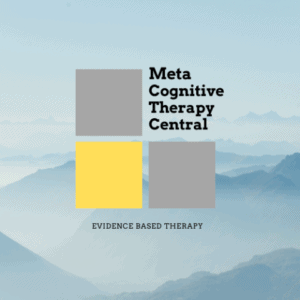
We are often asked about the difference between MCT and Mindfulness. Both approaches include stepping back from thoughts to let them pass. So, what is the difference, and is there any?
Metacognitive therapy (MCT) and mindfulness are not the same. MCT is built on a different theoretical foundation than mindfulness. Mindfulness attempts to minimize discomfort by anchoring attention into the present moment. In comparison, MCT challenges beliefs about thoughts to help reduce worry and rumination.
One of the techniques in MCT (Detached Mindfulness) is similar to mindfulness. Detached mindfulness allows the presence of thoughts without disengaging with them, which is also the idea behind mindfulness.
However, MCT is different in many other ways. According to Wells, the founder of Metacognitive therapy, it is more important to look at how theoretical approaches differ rather than how they are similar. Here are five differences to help you distinguish MCT from Mindfulness.
| Metacognitive Therapy (MCT) | Mindfulness | |
| Theoretical Foundation | S-REF model | Buddhism Philosophy |
| Change Mechanism (technique) | Detached mindfulness (stepping back from thoughts and doing nothing about them). Postponement of worry and rumination | Focus on breath Transform thoughts (fx. to clouds) |
| Goal | 1) Reduce rumination/worry 2) Change metacognitive beliefs 3) Defuse from thoughts 4) Thoughts are not facts 5) Thoughts don’t define us | 1) Change the relationship to thoughts and feelings 2) Feel calm and relaxed 3) Thoughts are not facts |
| Direct Change of Metacognition | Yes | No |
| Attention Paid to | Surroundings Daily activities | The breath The body |
1. Mindfulness and MCT use different techniques to stand back from thoughts
The technique used in mindfulness: focusing on the breath
Mindfulness has different definitions but is commonly defined as
“Paying attention in a particular way: on purpose, in the present moment, and non-judgementally.”
John Kabat-Zinn
Through the work of Jon Kabat-Zinn, mindfulness is associated with paying attention to the breath. This is to focus on the present moment without thinking about it.
Paying attention also includes being aware of the thought stream without judging it and accepting things as they are.
Mindfulness helps to understand that sensations in the body constantly change, which changes the relationship with inner events like feelings, pain, and thoughts.
The techniques used to stand back from thoughts in mindfulness are mainly through refocusing attention on the breath and imagining that thoughts are clouds in the sky that come and go independently. Or by putting thoughts on leaves in a running stream of water.
Mindfulness meditation, which stems from Buddhist practices, has become increasingly popular as a psychological treatment approach. For example, mindfulness-based stress reduction (MBSR) and mindfulness-based cognitive therapy (MBCT) are used to treat depression.
The techniques used in MCT: Detached mindfulness
MCT uses a technique called Detached Mindfulness (DM) to step back from thoughts mentally to reduce rumination and worry.
Detached mindfulness is defined as
A state of awareness of internal events, without responding to them with sustained evaluation, attempt to control or suppress them, or respond to them behaviorally…. by allowing the thought to occupy its own mental space without further action or interpretation…
Adrian Wells
DM has two features: 1) mindfulness which means being aware of thoughts, feelings, memories, and beliefs; and 2) detachment which means not engaging with thoughts, feelings, memories, and beliefs, and that a person (the self) is separated from these inner events.
Example of DM Technique:
For example, a patient who learns DM is instructed to deal with his intrusive thoughts the same way he would deal with an express train passing through the station:
“Your mind is like a busy station, and your thoughts and feelings are the trains passing through. Don’t try to stop and climb aboard a train that is passing by. Just be a bystander and watch your thoughts pass through.” (2)
Example of Mindfulness Technique:
A patient who learns mindfulness is asked to use imagery to respond to thoughts. For example, she should imagine her thoughts as printed on clouds and allowed to drift across the sky with the following instruction.
Although this instruction looks similar to the one of DM, there is a subtle difference. In the mindfulness form, the task involves responding to thoughts and then transforming them.
Additionally, mindfulness exercises like this are often used in combination with the patient focusing on his breath as an anchor.
DM is used as a stand-alone technique without focusing on the breath. It is a “do nothing” to thoughts, feelings, and other inner events instead of transforming, worrying, analyzing, suppressing, or ruminating about them.

2. The goals of Mindfulness and MCT are different
The goals of MCT and Mindfulness are very different. In therapy, Mindfulness is used to reduce discomfort, whereas MCT allows discomfort. Instead, MCT focuses on not engaging with distressing thoughts and feelings, enabling the mind to self-regulate.
The goal of using Detached mindfulness in MCT is to disengage from hours of rumination and worry because rumination and worry create mental illnesses like anxiety and depression.
The goal of MCT is not to avoid uncomfortable thoughts or feelings or to “neutralize” dangerous thoughts (as is the case in OCD).
MCT helps you to relate to thoughts differently and defuse your self-concept from thoughts, which means that you are not your thoughts.
The goal of mindfulness practices is to achieve relaxation and a changed relationship to sensations in the body, like physical pain or emotional discomfort. This is expected to create a feeling of calmness.
The common aim of practicing mindfulness is to concentrate on what is happening around you without judging anything you notice as good or bad. It comes with the benefits of managing physical pain, reducing stress, lowering anxiety, and achieving calmness.
3. MCT challenges metacognitive beliefs. Mindfulness doesn’t.
To detach from distressing thoughts and minimize relapse, MCT challenges false metacognitive beliefs about thinking. In Mindfulness, metacognitive beliefs are not addressed or changed.
Metacognitive beliefs are positive and negative beliefs about thinking. For example: “worrying helps me solve problems” is a positive metacognitive belief, and “I can’t control worrying” is a negative metacognitive belief.
If you don’t believe that you are in control of worrying, you won’t see the point of stepping back from thoughts and instead use other unhelpful strategies to reduce worrying like distractions and reassurance seeking.
Metacognitive therapy spends a great deal of time on changing metacognitive beliefs. For example, the therapist will have her patient start worrying uncontrollably and then ask him to stop. The point is to show that worrying is controllable. Changing metacognitive beliefs also prevent future relapse into anxiety, depression, and OCD.
Mindfulness in therapy settings does not directly try to change metacognitive beliefs. However, metacognitive awareness gets heightened as a side effect of mindfulness. Heightened metacognitive awareness is the ability to observe thoughts and feelings as separate from oneself. However, this awareness is in itself not enough to prevent future setbacks because important beliefs like “I can’t stop worrying” is still very high.

4. Mindfulness has many meanings, but Detached mindfulness is clearly defined
The term “mindfulness” is used in many different ways in psychological literature. Detached mindfulness is well defined as a technique
There is no one agreed-upon definition of mindfulness which makes it hard to measure the effectiveness of mindfulness treatment in psychotherapy.
Detached mindfulness is well defined: it is a technique that creates a consciousness of thoughts as internal events separate from facts. DM will help to achieve detachment from thoughts and feelings and teach you that you can flexibly control your attention.
5. Mindfulness uses body focus, while MCT doesn’t have body-focused anchors for attention
Mindfulness fosters a prolonged focus on the breath as a fundamental technique. MCT discourages body focus and teaches patients to move attention out from the body and toward their surroundings.
Mindfulness in meditation uses body-focus exercises to get grounded in the present moment, for example, by focusing on the breath to bring attention back to the present moment when caught up in thoughts.
Detached mindfulness doesn’t use any body-focus anchors for attention. Rather, patients are guided to ban any monitoring of inner events like thoughts, feelings, and sensations. Instead, they learn to move their attention around flexibly to their surroundings and the task at hand.
In MCT, patients learn to step back from thoughts without anchoring attention to something in the body. MCT theory claims that prolonged body focus maintains low mood and anxiety symptoms.
References
- Photo by Sharon Mccutcheon – Unsplash
- Wells A (2008). Metacognitive Therapy for Anxiety and Depression: New York: Guilford Press
- Photo by Frank Mckenna – Unsplash
- Photo by Max Vs. – Unsplash
- Lora Capobianco, David Reeves, Anthony P. Morrison, Adrian Wells. Group Metacognitive Therapy vs. Mindfulness Meditation Therapy in a Transdiagnostic Patient Sample: A Randomised Feasibility Trial. Psychiatry Research, Volume 259, 2018
- Allen NB, Chambers R, Knight W; Melbourne Academic Mindfulness Interest Group. Mindfulness-based psychotherapies: a review of conceptual foundations, empirical evidence and practical considerations. Aust N Z J Psychiatry. 2006 Apr;40(4):285-94. doi: 10.1080/j.1440-1614.2006.01794.x. PMID: 16620310.
